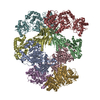+ データを開く
データを開く
- 基本情報
基本情報
| 登録情報 | データベース: PDB / ID: 8jqb | ||||||
|---|---|---|---|---|---|---|---|
| タイトル | Structure of Gabija GajA-GajB 4:4 Complex | ||||||
 要素 要素 |
| ||||||
 キーワード キーワード | IMMUNE SYSTEM / Anti-phage | ||||||
| 機能・相同性 |  機能・相同性情報 機能・相同性情報recombinational repair / 3'-5' DNA helicase activity / endonuclease activity / defense response to virus / 加水分解酵素; エステル加水分解酵素 / hydrolase activity / DNA binding / ATP binding / metal ion binding 類似検索 - 分子機能 | ||||||
| 生物種 |  | ||||||
| 手法 | 電子顕微鏡法 / 単粒子再構成法 / クライオ電子顕微鏡法 / 解像度: 3.2 Å | ||||||
 データ登録者 データ登録者 | Li, J. / Wang, Z. / Wang, L. | ||||||
| 資金援助 |  中国, 1件 中国, 1件
| ||||||
 引用 引用 |  ジャーナル: Nature / 年: 2024 ジャーナル: Nature / 年: 2024タイトル: Structures and activation mechanism of the Gabija anti-phage system. 著者: Jing Li / Rui Cheng / Zhiming Wang / Wuliu Yuan / Jun Xiao / Xinyuan Zhao / Xinran Du / Shiyu Xia / Lianrong Wang / Bin Zhu / Longfei Wang /   要旨: Prokaryotes have evolved intricate innate immune systems against phage infection. Gabija is a highly widespread prokaryotic defence system that consists of two components, GajA and GajB. GajA ...Prokaryotes have evolved intricate innate immune systems against phage infection. Gabija is a highly widespread prokaryotic defence system that consists of two components, GajA and GajB. GajA functions as a DNA endonuclease that is inactive in the presence of ATP. Here, to explore how the Gabija system is activated for anti-phage defence, we report its cryo-electron microscopy structures in five states, including apo GajA, GajA in complex with DNA, GajA bound by ATP, apo GajA-GajB, and GajA-GajB in complex with ATP and Mg. GajA is a rhombus-shaped tetramer with its ATPase domain clustered at the centre and the topoisomerase-primase (Toprim) domain located peripherally. ATP binding at the ATPase domain stabilizes the insertion region within the ATPase domain, keeping the Toprim domain in a closed state. Upon ATP depletion by phages, the Toprim domain opens to bind and cleave the DNA substrate. GajB, which docks on GajA, is activated by the cleaved DNA, ultimately leading to prokaryotic cell death. Our study presents a mechanistic landscape of Gabija activation. | ||||||
| 履歴 |
|
- 構造の表示
構造の表示
| 構造ビューア | 分子:  Molmil Molmil Jmol/JSmol Jmol/JSmol |
|---|
- ダウンロードとリンク
ダウンロードとリンク
- ダウンロード
ダウンロード
| PDBx/mmCIF形式 |  8jqb.cif.gz 8jqb.cif.gz | 755.3 KB | 表示 |  PDBx/mmCIF形式 PDBx/mmCIF形式 |
|---|---|---|---|---|
| PDB形式 |  pdb8jqb.ent.gz pdb8jqb.ent.gz | 629.2 KB | 表示 |  PDB形式 PDB形式 |
| PDBx/mmJSON形式 |  8jqb.json.gz 8jqb.json.gz | ツリー表示 |  PDBx/mmJSON形式 PDBx/mmJSON形式 | |
| その他 |  その他のダウンロード その他のダウンロード |
-検証レポート
| 文書・要旨 |  8jqb_validation.pdf.gz 8jqb_validation.pdf.gz | 414.1 KB | 表示 |  wwPDB検証レポート wwPDB検証レポート |
|---|---|---|---|---|
| 文書・詳細版 |  8jqb_full_validation.pdf.gz 8jqb_full_validation.pdf.gz | 459.9 KB | 表示 | |
| XML形式データ |  8jqb_validation.xml.gz 8jqb_validation.xml.gz | 72.5 KB | 表示 | |
| CIF形式データ |  8jqb_validation.cif.gz 8jqb_validation.cif.gz | 108.9 KB | 表示 | |
| アーカイブディレクトリ |  https://data.pdbj.org/pub/pdb/validation_reports/jq/8jqb https://data.pdbj.org/pub/pdb/validation_reports/jq/8jqb ftp://data.pdbj.org/pub/pdb/validation_reports/jq/8jqb ftp://data.pdbj.org/pub/pdb/validation_reports/jq/8jqb | HTTPS FTP |
-関連構造データ
| 関連構造データ |  36563MC  8jq9C  8jqcC  8wy4C  8wy5C  8x51C  8x5iC  8x5nC M: このデータのモデリングに利用したマップデータ C: 同じ文献を引用 ( |
|---|---|
| 類似構造データ | 類似検索 - 機能・相同性  F&H 検索 F&H 検索 |
- リンク
リンク
- 集合体
集合体
| 登録構造単位 | 
|
|---|---|
| 1 |
|
- 要素
要素
| #1: タンパク質 | 分子量: 67079.469 Da / 分子数: 4 / 由来タイプ: 組換発現 由来: (組換発現)  遺伝子: gajA, IIE_04982 / 発現宿主:  参照: UniProt: J8H9C1, 加水分解酵素; エステル加水分解酵素 #2: タンパク質 | 分子量: 57757.656 Da / 分子数: 4 / 由来タイプ: 組換発現 由来: (組換発現)  遺伝子: gajB, IIE_04983 / 発現宿主:  |
|---|
-実験情報
-実験
| 実験 | 手法: 電子顕微鏡法 |
|---|---|
| EM実験 | 試料の集合状態: PARTICLE / 3次元再構成法: 単粒子再構成法 |
- 試料調製
試料調製
| 構成要素 | 名称: GajA-GajB 4:4 Complex / タイプ: COMPLEX / Entity ID: all / 由来: RECOMBINANT |
|---|---|
| 分子量 | 値: 0.512 MDa / 実験値: YES |
| 由来(天然) | 生物種:  |
| 由来(組換発現) | 生物種:  |
| 緩衝液 | pH: 8 |
| 試料 | 包埋: NO / シャドウイング: NO / 染色: NO / 凍結: YES |
| 急速凍結 | 凍結剤: ETHANE / 湿度: 100 % |
- 電子顕微鏡撮影
電子顕微鏡撮影
| 実験機器 |  モデル: Titan Krios / 画像提供: FEI Company |
|---|---|
| 顕微鏡 | モデル: FEI TITAN KRIOS |
| 電子銃 | 電子線源:  FIELD EMISSION GUN / 加速電圧: 300 kV / 照射モード: FLOOD BEAM FIELD EMISSION GUN / 加速電圧: 300 kV / 照射モード: FLOOD BEAM |
| 電子レンズ | モード: BRIGHT FIELD / 最大 デフォーカス(公称値): 1800 nm / 最小 デフォーカス(公称値): 1500 nm |
| 撮影 | 電子線照射量: 50 e/Å2 / フィルム・検出器のモデル: GATAN K3 (6k x 4k) |
- 解析
解析
| EMソフトウェア | 名称: PHENIX / バージョン: 1.20.1_4487: / カテゴリ: モデル精密化 | ||||||||||||||||||||||||
|---|---|---|---|---|---|---|---|---|---|---|---|---|---|---|---|---|---|---|---|---|---|---|---|---|---|
| CTF補正 | タイプ: PHASE FLIPPING AND AMPLITUDE CORRECTION | ||||||||||||||||||||||||
| 3次元再構成 | 解像度: 3.2 Å / 解像度の算出法: FSC 0.143 CUT-OFF / 粒子像の数: 2245766 / 対称性のタイプ: POINT | ||||||||||||||||||||||||
| 原子モデル構築 | プロトコル: AB INITIO MODEL / 空間: REAL | ||||||||||||||||||||||||
| 拘束条件 |
|
 ムービー
ムービー コントローラー
コントローラー










 PDBj
PDBj

